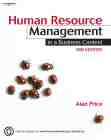Bestselling Books
|
Bestselling Books |
|
| US Bestsellers UK Bestsellers France - Meilleurs Ventes Canada Bestsellers Germany Bestsellers |
 Hooked on books? BestBooks.biz features book-related articles, book extracts and book selections from the best books - past and present. |
HRM policies and their consequencesAdapted from Human Resource Management in a Business Context, 3rd edition (2007) Beer et al (Managing Human Assets by Michael Beer, Richard E. Walton, Bert A. Spector, 1984) propose that long-term consequences (both benefits and costs) of human resource policies should be evaluated at three levels:
- efficiency
Beer et al suggest that managers use their 4 Cs to analyse the questions raised above. 1. Commitment. Do HRM policies enhance the commitment of employees to their work and their organization - and to what extent? Improved commitment may lead to more loyalty and better performance for the business. It can also benefit the individual through enhanced self-worth, dignity, psychological involvement, and identity. And there is a societal spin-off because of these psychological benefits. 2. Competence. Do HRM policies serve to attract, keep, or develop employees who have valuable skills and knowledge - both now and in the future? Again there are benefits at all three levels. If skills and knowledge are there when required, the organization benefits, and its employees 'experience an increased sense of self-worth and economic well-being.' 3. Cost effectiveness. The cost effectiveness of particular HRM policies can be evaluated in terms of wages, benefits, turnover, absenteeism, strikes, etc. The costs can be judged for organizations, individuals, and society as a whole. 4. Congruence. The question can be raised about the level of congruence in HRM policies between, for example: - management and employees,
This article is based on Human Resource Management in a Business Context by Alan Price (3rd edition, 2007) |
 in a Business Context by Alan Price
|
|
|
|
|
|
|
|
|
| Copyright © 2000-20l7 Alan Price and BestBooks.biz contributors. All rights reserved. |